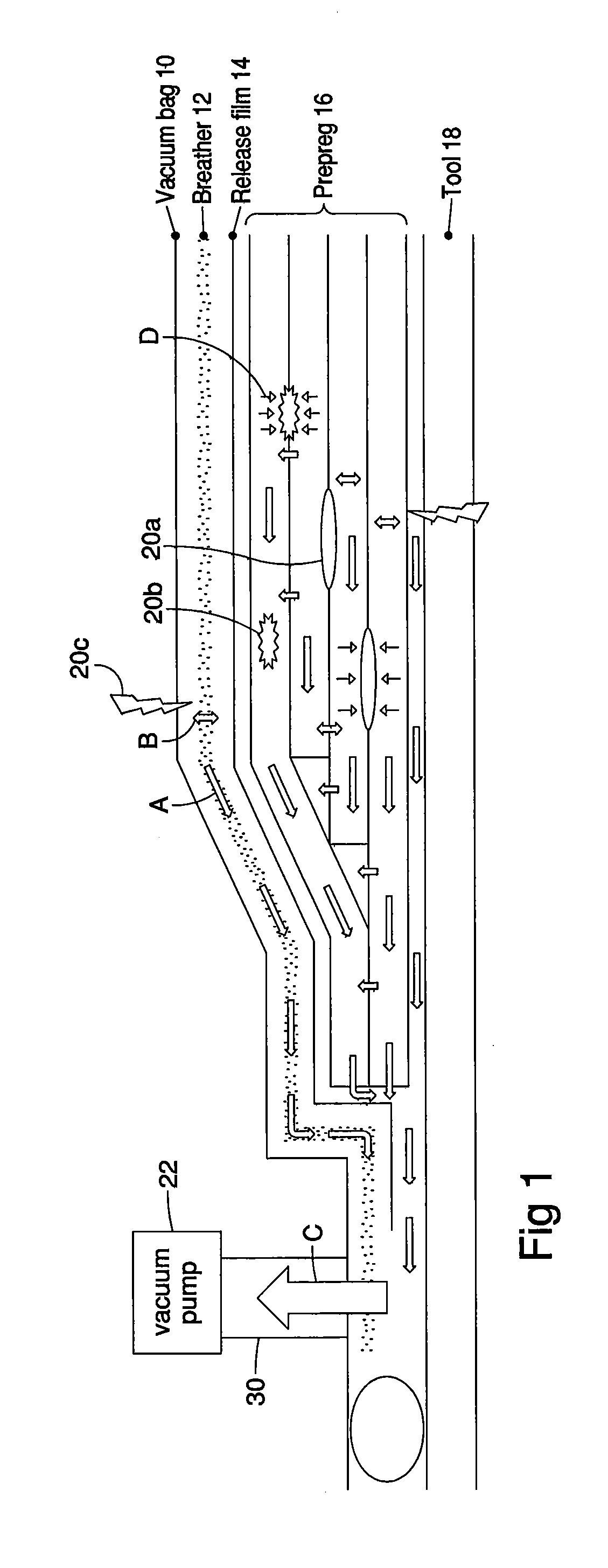Detection, Monitoring, and Management of Gas Presence, Gas Flow and Gas Leaks in Composites Manufacturing
a composites manufacturing and gas flow technology, applied in the direction of fluid tightness measurement, structural/machine measurement, instruments, etc., can solve the problems of voids and porosities in composites, leaks are a particularly common source of quality problems, and considerable time and effort is expended in managing and controlling vacuum pulled on parts, etc., to speed up the process of leak detection and repair, reduce the ambiguity and cost of leak check data
- Summary
- Abstract
- Description
- Claims
- Application Information
AI Technical Summary
Benefits of technology
Problems solved by technology
Method used
Image
Examples
Embodiment Construction
[0093]A schematic representation of void generation and dissipation is shown in FIG. 1. A vacuum bag or member 10 overlays a breather layer 12, which overlaps a release film 14. Release film 14 overlaps layers of pre-preg 16 which have been laid-up on tool or mould 18. As used herein, the term pre-preg refers to pre-impregnated composite fibres where a pre-cured or partially cured matrix bonding material, such as epoxy, is already present. These usually take the form of a weave or are uni-directional. Gas filled voids may be formed within pre-preg 16, caused by for example entrapped air 20a, volatiles or off-gasing 20b, or leaks 20c in bag 10, tool or mould 18, etc. Gas transport may be co-planar within or interleaved between the various layers as shown by arrows A, or may be orthogonal to the layers as shown by arrows B. Collectively the gas migrates to the vacuum source, indicated in FIG. 1 by arrow C leading to vacuum pump 22. Arrows D indicate void shrinkage or collapse.
[0094]FI...
PUM
| Property | Measurement | Unit |
|---|---|---|
| Temperature | aaaaa | aaaaa |
| Pressure | aaaaa | aaaaa |
| Power | aaaaa | aaaaa |
Abstract
Description
Claims
Application Information
 Login to View More
Login to View More - R&D
- Intellectual Property
- Life Sciences
- Materials
- Tech Scout
- Unparalleled Data Quality
- Higher Quality Content
- 60% Fewer Hallucinations
Browse by: Latest US Patents, China's latest patents, Technical Efficacy Thesaurus, Application Domain, Technology Topic, Popular Technical Reports.
© 2025 PatSnap. All rights reserved.Legal|Privacy policy|Modern Slavery Act Transparency Statement|Sitemap|About US| Contact US: help@patsnap.com



